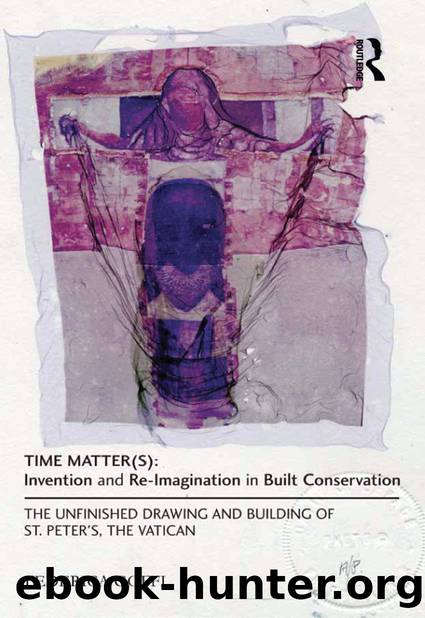Time Matter(s): Invention and Re-Imagination in Built Conservation by Goffi Federica;

Author:Goffi, Federica;
Language: eng
Format: epub
Publisher: Taylor & Francis Group
Published: 2016-08-15T00:00:00+00:00
This figure has intentionally been removed for copyright reasons. To view this image, please refer to the printed version of this book.
5.2 Alesso Baldovinetti, 1470â1472 ca. Trinity with Sts John Gualbert and Benedict. Tempera on Panel. Florence.
This allows apprehending the 1590s ichnography as representation of the Church born on the Golgotha. The 1571 drawing puts âChristâs headâ at the top, suggesting that the sheet can be read not only horizontally as plan (Vitruvian man), but also elevationally as crucifixion.19 The experience of walking from the entry to the altar is equivalent to ascending, getting closer to a higher realm; achieved metaphorically by contemplating the ichnography.
Alfarano is a messenger raising the veil of a metaphorical sopracielo.20 The practice of unveiling sacred images transforms through time. It starts as an act of physically veiling by hanging cloths in front of sacred images and develops into a metaphorical veiling achieved pictorially within the frame of the canvas. Schmidt sees the beginning of this practice in the myth narrated by Pliny in his Natural History (XXXV, 65), where he describes the âillusionistically-rendered curtainâ which Parrhasius depicted to deceive Zeuxis.21 The working of Alfaranoâs drawing reminds one of:
the veil, that is, the curtain of the tabernacle which, according to the oldest Eastern tradition, symbolizes the sky separating earth from heaven.22
In Baldovinettiâs representation the curtain is pulled away by angels revealing the Holy Trinity and uncovering a transcendent world within a visible representation.23 Alfarano builds a complex iconographic frame for both drawing and print. The frames are essential in providing access through contemplation to an encrypted significance. Glenn Peers states that frames are key sites for the interpretation of meaning and observes that in the Byzantine framing of icons:
margins, edges, details of works of art, the framing device cease to be liminal and become integral.24
Analyzing the marginalia in the 1590 print it is possible to observe that key elements of the 1571 hybrid drawing have been substituted with new ones, translating their allegoric presence. In the top center of the print a winged cherubâs head supporting festoons on each side, with a wind rose below, substitutes Veronicaâs veil (Figureâs 1.4 and 1.3).25 The winged cherubâs head might be read in light of Schmidtâs observation, as the messenger which makes revelation possible, an act metaphorically symbolized by the lifting of the veil.26 Traditional iconographies of Veronicaâs veil often make use of the allegory of raising the curtain to reveal Christâs effigy. Christine Sciacca documents the concealing and revealing of sacred images within sacred codices with actual fragments of fabric sawn into a page.27 The early thirteenth century Gradual and Sacramentary of Hainricus Sacrista where historiated initials are covered with small pieces of fabric is telling. A depiction of the âAssumptionâ (Figure 5.3) demonstrates how, the raising of the veil by angelic figures, allows the epiphany of Christâs image. The reader identifies by literally raising the silk cloth, unveiling an image concealed within the text thereby allowing the beholder to gain access to the heavenly realm.
By placing Old St.
Download
This site does not store any files on its server. We only index and link to content provided by other sites. Please contact the content providers to delete copyright contents if any and email us, we'll remove relevant links or contents immediately.
| Landmarks & Monuments | Religious Buildings |
| Residential |
Kathy Andrews Collection by Kathy Andrews(10554)
The remains of the day by Kazuo Ishiguro(7577)
Spare by Prince Harry The Duke of Sussex(4222)
Paper Towns by Green John(4178)
The Body: A Guide for Occupants by Bill Bryson(3816)
Be in a Treehouse by Pete Nelson(3234)
Harry Potter and the Goblet Of Fire by J.K. Rowling(3078)
Goodbye Paradise(2977)
Never by Ken Follett(2910)
Into Thin Air by Jon Krakauer(2711)
The Remains of the Day by Kazuo Ishiguro(2627)
The Genius of Japanese Carpentry by Azby Brown(2616)
The Cellar by Natasha Preston(2605)
Drawing Shortcuts: Developing Quick Drawing Skills Using Today's Technology by Leggitt Jim(2537)
120 Days of Sodom by Marquis de Sade(2446)
Architecture 101 by Nicole Bridge(2356)
Machine Learning at Scale with H2O by Gregory Keys | David Whiting(2317)
The Man Who Died Twice by Richard Osman(2309)
Industrial Automation from Scratch: A hands-on guide to using sensors, actuators, PLCs, HMIs, and SCADA to automate industrial processes by Olushola Akande(2127)
